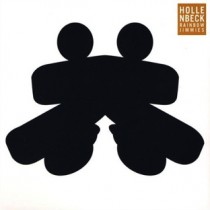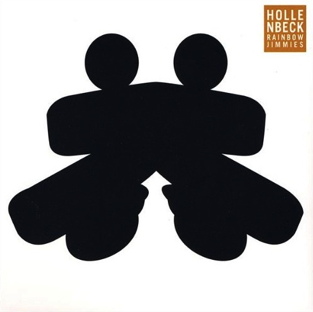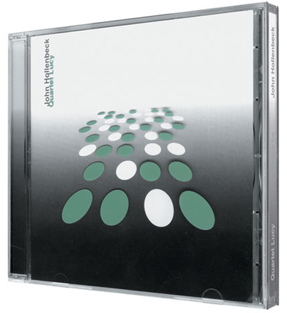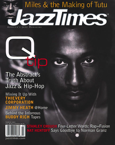Rainbow Jimmies is more about Hollenbeck the composer than it is about Hollenbeck the drummer, or Hollenbeck the jazzman…Amazingly diverse and ceaselessly fascinating, Rainbow Jimmies is an essential document by one of America’s most inventive and original composers, and a must-have recording for fans of Hollenbeck’s Claudia Quintet.” – Dave Wayne
JAZZTIMES 2001
no images, Quartet Lucy, The Claudia Quintet
“The apparent ease with which Hollenbeck moves among polymetrics and polytones as well as various genres, bands and disciplines is impressive, and his unique style of accessible but willful eclecticism is evident on his debut trio of CDs.”
– Christopher Porter
CODA MAGAZINE 2002
no images
Quartet Lucy
The Claudia Quintet
“Drummer John Hollenbeck has a widely varied musical background, and his first three recordings as a leader capture a large part of it, while maintaining some stylistic threads that reassure that he’s more than a musical magpie.”
– James Hale
HARTFORD COURANT 2010
“Rainbow Jimmies is a wondrous and varied collection of [Hollenbeck’s] latest compositions.”
– Richard Kamins

Rainbow Jimmies

Todd Reynolds violin
Matt Moran vibraphone
John Hollenbeck drums
[performing Gray Cottage Studies]
ETHOS PERCUSSION GROUP
Trey Files, Eric Phinney,
Yousif Sheronick, David Shively
[performing Ziggurat (interior)]
THE CLAUDIA QUINTET
with SPECIAL GUEST: Mark Stewart guitar
[performing Rainbow Jimmies]
THE CLAUDIA QUINTET
Chris Speed clarinet/tenor sax; Ted Reichman accordion/organ; Drew Gress bass; Matt Moran vibraphone; John Hollenbeck drums/piano
[performing Sinanari (acoustic remix)]
THE YOUNGSTOWN STATE PERCUSSION COLLECTIVE AND SAXOPHONE QUARTET
Glenn Schaft faculty advisor
Michael Anderson, Dean Anshutz,
Cory Doran, Tim Hampton,
Brian Sweigart (leader) percussion
Chris Coles, Sara Kind, Evan Hertrick,
Tim Sharek alto saxophones
[performing Ziggurat (exterior)]
On April 1, 2009 John Hollenbeck released “Rainbow Jimmies,” a CD of compositions for various ensembles including a trio of violinist Todd Reynolds (Bang On A Can, Steve Reich, Ethel), vibraphonist Matt Moran (Claudia Quintet, Slavic Soul Party), and Hollenbeck; The Youngstown Percussion Collective and Saxophone Quartet; Ethos Percussion Group; and Hollenbeck’s world-renowned band The Claudia Quintet with special guest guitarist Mark Stewart (Paul Simon, Bang On A Can).
John’s jazz-oriented work has garnered an extremely strong critical response, including numerous awards and a Grammy nomination for his first large ensemble recording, yet Hollenbeck is not a jazz composer in any traditional sense. He has a strong background in classical composition and has received commissions from leading ensembles and musicians in the US and Europe, yet Hollenbeck is not strictly a classical composer either. Hollenbeck represents a major break from the traditional boundaries between composition styles. He freely integrates a range of techniques from jazz and classical music, as well as popular and world styles, on a deep formal level. And yet, he is not an “eclectic” musician. Hollenbeck has created a unique musical language for the twenty-first century. “Rainbow Jimmies” is a strong statement of that language.
“Gray Cottage Studies,” written for violinist Todd Reynolds, was composed as part of a project funded by the Guggenheim Foundation Fellowship Hollenbeck received in 2007. It features regular Hollenbeck collaborator Matt Moran and Hollenbeck himself providing percussive backing for a virtuoso display of standard violin technique. It includes many of the aspects of Hollenbeck’s music that have endeared him to listeners: propulsive grooves, ravishing melodies, and sections of meditative grace.
“Ziggurat (exterior)” and “Ziggurat (interior)” are two distinct yet related pieces, both comprised of traditional and non-traditional notation techniques. Inspired by both ancient (ziggurats) and modern construction (the sounds of building sites in contemporary Manhattan), the Ziggurat pieces present percussion ensembles with the challenge of working as a unit to create a unique performance out of the materials Hollenbeck provides.
For twelve years the Claudia Quintet has been Hollenbeck’s main working band. It has charmed and bewildered audiences from Alabama to the Amazon. Encompassing aspects of a chamber ensemble, a jazz band and a rock and roll group, the Claudia Quintet’s unique combination of sounds and personalities has earned it a special place in the hearts of critics and listeners world-wide. It features Chris Speed (clarinet and tenor saxophone), Matt Moran (vibraphone), Ted Reichman (accordion), Drew Gress (bass), and Hollenbeck himself (drums and percussion).
“Sinanari” was written for the Claudia Quintet’s cross-cultural educational journey to Istanbul, commissioned by the Weill Music Institute at Carnegie Hall. It is Hollenbeck’s arrangement of a traditional Turkish song, taken apart and put back together (“remixed,” as John says) on top of a John Bonham-esque drum part.
The title track “Rainbow Jimmies” was originally commissioned and performed by the Bang On a Can All Stars as part of their People’s Commissioning Fund project. Performed here by the Claudia Quintet plus the All-Stars’ guitar virtuoso Mark Stewart, “Rainbow Jimmies” marks a summation of Hollenbeck’s work to date. The piece brings together many of Hollenbeck’s musical obsessions (patterns, complex time signatures, heartfelt melodies) and then shatters them into a prismatic display of compositional skill and instrumental fireworks. When Hollenbeck showed the guitar part to Ben Monder, not exactly a slacker in guitar technique, his response was: “the only person that I think could play this is Mark Stewart.” “Rainbow Jimmies” is a stunning example of compositional and instrumental virtuosity, but like all of Hollenbeck’s music, it is expressive at its core.
Quartet Lucy

Dan Willis English horn, tenor/sop sax, flute
Jonas Tauber cello
Skuli Sverrison electric bass, banjo sexto
Theo Bleckmann voice, piano
John Hollenbeck drums, piano, berimbau, comp.
Notes on Quartet Lucy by John Hollenbeck
Soon after Claudia took hold, I realized I needed a song-oriented outlet in which to explore the world music influences that I love; express the spiritual paths that inspire me; and re-interpret the influence of the ECM recordings that are a center piece in my love of music (such as Eberhard Weber’s “Later that Evening,” the recordings of Sidsel Endressen, Keith Jarrett, Jan Garbarek, Oregon and Pat Metheny).
I had just started playing with vocalist Theo Bleckmann and was awed by his versatility and spirit. Fortunately he responded eagerly to my new group concept. Somehow, I knew from the beginning that I needed English horn. My good friend and college roommate, Dan Willis, was the perfect choice. He is a great saxophonist/woodwind specialist, and was in fact an oboe major when we first met.
I originally was thinking of a group concept that would evoke the sound of Americana. Again, Reuben Radding stepped into the picture and recommended pedal steel guitarist Bob Hoffnar, one of the few players of that difficult instrument who could improvise in an non-Nashville environment AND read music. While Bob put his heart into it, I realized that my vision was actually more ECM than country, and that there was a good reason why composers who like fifths do not attempt to write for the pedal steel.
At that time I hired bassist Skuli Sverrison, who gave the quartet its glue. Words cannot express what Skuli’s unique sound concept brought to Lucy. Because Skuli is now very busy with Laurie Anderson, I chose to slightly alter Lucy’sscope and broaden her palette at the same time. I now use cello, which gives me the option of writing music with a chamber sensibility. Jonas Tauber is an accomplished chamber musician who also loves to improvise. He brings extreme amounts of delight and enthusiasm to every musical encounter.
The name Lucy is an amalgamation of:
1. A pet name for my college girlfriend – someone who was very interested in a “good song”.
2. The name of a girl I admired from afar in my high school days who, being a “southern belle,” epitomized some aspects of Americana that I love.
3. The Spanish word luz, meaning “light” or “enlightenment.”
The female name game doesn’t stop there. I have a dormant trio called the Mary-Noelle Trio – dedicated to the former “Empress of Festivities” at the Knitting Factory, Mary-Noelle Dana. She was, of course, very flattered (one way to get a gig at the KF Fest!).
no images

Dave Liebman, Ellery Eskelin &
Rick Dimuzio tenor saxophones
Theo Bleckmann voice
Ben Monder electric guitar
Ray Anderson, David Taylor &
Tim Sessions trombones
John Hollenbeck drums, percussion, autoharp
Liner Notes to no images:
While drummer/composer John Hollenbeck chose to title his debut recording no images, what becomes clear quite quickly is that there is indeed a visual analogue to every piece on the album. In some cases the images are specific and concrete; in others they’re more impressionistic and subject to interpretation. One could even posit a visual counterpart for the two sets of completely abstract miniatures. But one of the most remarkable things about the disc – a long overdue documentation of one of New York’s most impressive contemporary musical artists (and best kept secrets) – is the sheer range and diversity of compositional strategies he employs to evoke his gallery of unseen imagery.
“BlueGreenYellow,” for three tenor saxophonists and drums, is a study in musical synesthesia – strictly speaking, a medical condition in which sensory inputs are mixed unusually: for instance, “hearing colors” in which each saxophonist represents one of the colors in the title. First up in order of solos is David Liebman, who returned to the tenor for this 1995 session after many years as a soprano specialist, providing the color “blue.” Ellery Eskelin represents the color “green,” and also demonstrates the element of chance inherent in writing music for improvisers; according to Hollenbeck, the shade of green he’d had in mind (“kelly green”) was not the shade that Eskelin actually played (“kind of olive green”). Rick DiMuzio, an old friend of Hollenbeck’s, was the only “yellow” tenor he could find, he says. His section goes beyond color into onomatopoeia as well: “At the end of his section, he tells – plays – a joke, with severe laughter following.”
“Without Morning” teams Hollenbeck with two fellow explorers of the gray area between composition and improvisation, vocalist Theo Bleckmann and guitarist Ben Monder. Monder, one of the most promising young guitarists on the contemporary New York scene, is Hollenbeck’s former roommate, and the two share a longstanding musical empathy. “Without Morning” is Hollenbeck’s first meeting with Bleckmann, who has since become one of his most frequent collaborators. The two have recorded an intimate and wide-ranging self-released duo CD, Static Still, and have also worked together in the ensembles of composer/vocalist Meredith Monk. The melancholy piece, according to Hollenbeck, is a “musical goodbye” – the resolution of a love affair.
The “Liebman/Hollenbeck Vignettes” and “Eskelin/Hollenbeck Vignettes” are two sets of six spontaneously improvised musical encounters between the drummer and two of his “BlueGreenYellow” collaborators. Liebman’s reputation stretches back decades to his work with such famed leaders as Miles Davis and Elvin Jones, while Eskelin is one of the more versatile hornmen to come to the fore in the 1990s. The pieces heard on the album are unedited and presented in the sequence in which they were recorded – in a sense, each is a series of stream-of-consciousness conversations. Each player brings his own measure of order and chaos to the proceedings, and despite obvious timbre similarities, comparison of the two sets readily demonstrates the wide range of expressiveness and individuality afforded by free improvisation.
Hollenbeck makes use of a recorded sermon by Dr. Martin Luther King, Jr. in “The Drum Major Instinct.” Conceived during Hollenbeck’s last year at the Eastman School of Music, the piece is scored for two tenor trombones, bass trombone, drumset, and the taped voice of King. According to Hollenbeck, he chose trombones “because statistically they’re the most humble in a big band setting – they are the team players.” He had not yet encountered the sanctified trombone choirs of Harlem, but had been impressed with trombonist Gary Valente’s “preaching” in the band of Carla Bley, leading him to feel that the instrument had the right “spiritual characteristics” for the piece. Nor had he heard drummer Max Roach’s LP Chatahoochie Red, which also makes use of a King speech. Hollenbeck sets King’s words in an entirely different way from his legendary forebear, yet both find an artistic affinity in the orator’s martial cadences.
“The Drum Major Instinct” is performed in total darkness, so that the presence of the musicians would be as invisible as that of the orator himself – necessitating memorization of the written materials. The piece begins and ends with a simple four-chord cell, and follows the rhythms of King’s heroic oratory – drawing upon its emotional power while simultaneously creating a dramatic setting for it. At times, the players follow the cadences of the speech, while elsewhere they comment freely upon it, like a congregation echoing the words of the minister. The piece builds in intensity along with the sermon, resolving into a chorale as King’s message reaches its climax. At the end, the instrumentalists follow King down the aisle of the church and shut the door behind them as they exit.
Ending the album is a very recent work, “no images,” a concept adapted from an earlier composition and based upon a poem by Waring Cuney. In the poem, a young woman longs to see her image reflected in the waters of a flowing river, but can’t envision it in the dishwater of her daily life. Hollenbeck evokes the desired reflection by simply playing his late grandmother’s old Autoharp with the whirring blades of a small personal fan – capturing a fleeting, evanescent image through a decidedly un-technocratic use of technology. It’s another small but telling example of the poetic sensitivity and ingenuity that Hollenbeck brings to bear in each new creative challenge he sets for himself.
— Steve Smith 8/01

 MENU
MENU









